Ciena’s vision of 5G xHaul transport networks, ahead of India’s 5G launch at IMC 2022
India Mobile Congress is back in-person after two years. Even more exciting is the official 5G rollout announcement in major Indian cities, details of which will be revealed at the IMC 2022 by the Honorable Prime Minister, Shri Narendra Modi.
5G enables new applications and use cases for Smart Cities, Industry 4.0, gaming, EdTech, HeathTech, AgriTech, FinTech, the Metaverse, and much more. While all of this is exciting, there is a substantial effort behind the scenes to make 5G a success in India. One of the most important aspects is the creation of a seamless network backbone emerging out of and on top of legacy infrastructure into an automated, AI/ML-driven network.
Here is a preview of what to expect at Ciena’s booth and speaker sessions:
Own 5G. Own the edge.
5G xHaul transport networks interconnect Radio Units (RUs), Distributed Units (DUs), and Centralized Units (CUs), along with the Radio Access Network (RAN). to the 5G Core. Managing the entire network with the large amounts of data pouring in with the new 5G use cases can be challenging. Hence, structuring the data and bringing it closer to humans and machines (think IoT), by leveraging edge computing, is key.
Open, automated, and scalable
5G is based on advancing standards and evolving technologies, which requires intelligent, open, interoperable, and virtual networks where operators are provided with a choice to assess real-time data, increase network operation flexibility, and reduce service costs. Analytics-driven network automation will replace static legacy infrastructure and will leverage a multi-vendor, multi-domain network allowing for best-in-breed performance.
Network slicing
Upcoming 5G use cases will require differentiated Service Level Agreements (SLAs), which will require end-to-end network upgrades. This will enable network slicing that will provide application-specific performance over shared infrastructure. Network platforms must brace both soft (Segment Routing) and hard slicing (FlexEthernet) into a Software-Defined Infrastructure (SDN) allowing for services to be delivered in a more dynamic and adaptive way.
Minimize space, power consumption, increase capacity
By converging fronthaul, midhaul, and backhaul over common 4G/5G infrastructure that leverages compact form-factors, diverse ports, varied mounting options, and wide temperature range support, mobile network operators (MNOs) can achieve cost savings while minimizing power consumption and carbon footprint. This will help optimize both performance and costs.
Focus on local research and development
The last and most crucial point is being closer to the customer with local research, development, and manufacturing. While local knowledge helps in gaining a competitive edge with respect to utilized technologies, local manufacturing saves costs related to infrastructure deployment. Ciena truly believes in the Make in India vision and our last 15 years of presence in India have proven this belief resulting in patents for designing technology for India-specific needs.
Ciena will address 5G transport challenges and opportunities at IMC 2022. Stay tuned for the schedule on our social media channels. We are also arranging a virtual lab visit for booth visitors, so do meet us and we would love to take you through our state-of-the-art testing and research facility in Gurugram, Haryana.
See you at IMC-22!!!!












